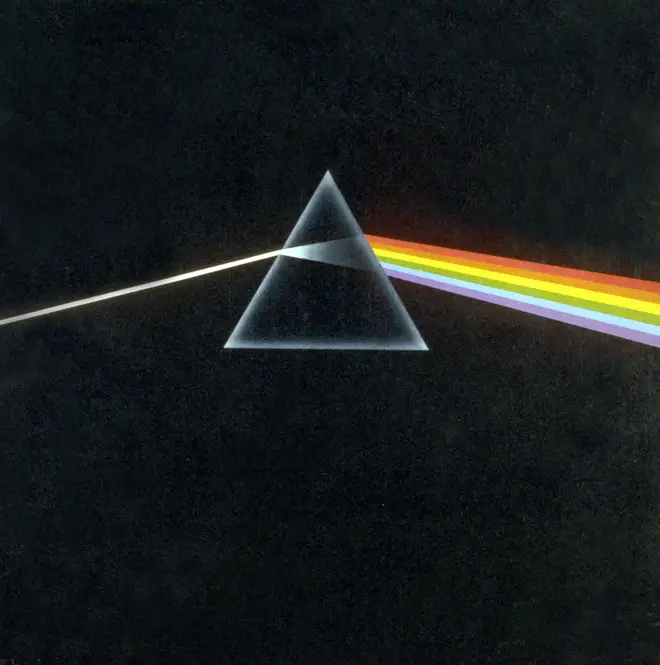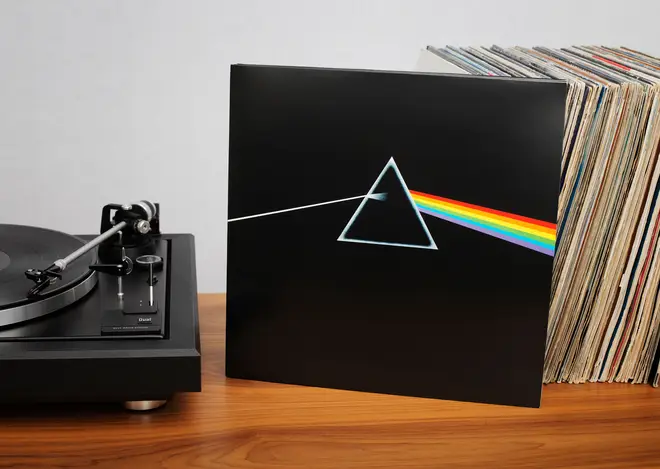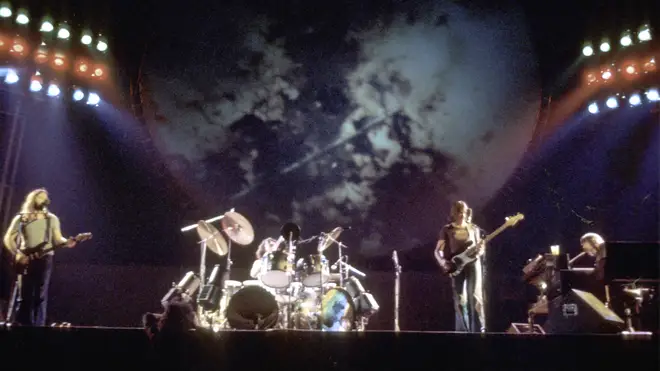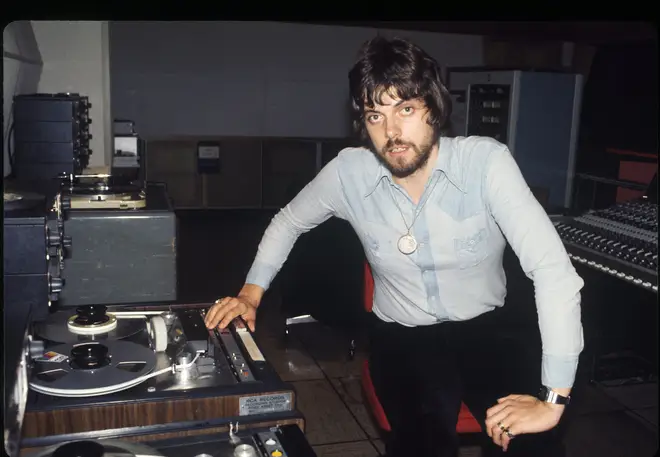Pink Floyd's The Dark Side of the Moon: 10 amazing facts about the classic album
28 February 2023, 16:33 | Updated: 9 May 2024, 16:27

Pink Floyd - The Dark Side of the Moon 50th Anniversary unboxing video
Pink Floyd's The Dark Side of the Moon is one of the biggest-selling albums in pop history.
Listen to this article
It's safe to say that the surviving members of Pink Floyd don't look like reuniting any time soon.
Roger Waters and David Gilmour are on as bad terms as they've ever been – which is certainly saying something given their past altercations.
- Pink Floyd: A timeline of all their feuds and fallouts over the years
- Pink Floyd's 15 greatest songs ever, ranked
- Listen to the Gold Greats Live Playlist on Global Player
None of that will stop us from enjoying Pink Floyd's stunning back catalogue, and not least their breakthrough 1973 album The Dark Side of The Moon.
As the record celebrates its 50th anniversary, the band have put out their umpteenth remaster/reissue/deluxe box set, while its main creative force Roger Waters has also decided to re-record the whole thing just by himself.
How much do you know about the classic album? Check out ten amazing facts you may or may not have known about The Dark Side of the Moon.
1. The Dark Side of the Moon is the fourth-best selling album OF ALL TIME

We all know that The Dark Side of the Moon has sold a lot of copies, but did you know just how many?
It's sold a certified 25 million copies (and claimed sales are even higher at 45 million copies).
Released on March 17, 1973, the album only spent one week on the top of the US Billboard 200 charts.
Here in the UK, the album didn't even get that. It was released a couple of weeks earlier on March 1, it stalled at number 2 and was kept off the top by... a K-Tel compilation called 20 Flash Back Greats of the Sixties.
On both sides of the Atlantic, the album has clocked up hundreds of weeks in the chart – being listed in the Guinness book of World Records for being there longer than any other album in history – with those sales piling up over the years.
It's "only" the seventh-biggest selling album of all time in the UK, in a list topped by Queen's Greatest Hits followed by ABBA's Gold and The Beatles' Sgt Pepper's Lonely Hearts Club Band.
But if you look at the global rankings, it's all the way up at number four, only beaten by Michael Jackson's Thriller, AC/DC's Back in Black and the soundtrack of The Bodyguard.
2. There are over 1,000 (ONE THOUSAND!) different officially-released versions of The Dark Side of the Moon out there

The Dark Side of The Moon is owned by a LOT of people, that's true.
But we're also betting that some Pink Floyd fans own more than one copy of their best-known album, and we're not just talking regular upgrades from vinyl to tape to cassette to CD, either.
According to Discogs, as of September 2020 there are over 1,000 different editions of The Dark Side of the Moon floating about.
Gatefold sleeves, special stickers, posters, quadrophonic and surround sound, slight artwork tweaks... the list is endless.
"New and previously undocumented versions of DSOTM get added to the database frequently making it one of the most interesting titles to focus on for 'deep collectors'," notes the muso database/marketplace.
3. The Dark Side of the Moon was developed during the band's live shows and was performed in concert before recording even started

Most concept albums are painstakingly crafted in the studio before they're taken out on the road, if they're ever played live at all.
Pink Floyd turned that whole practice on its head with The Dark Side of The Moon, which was developed during a series of live performances.
The band put some demos together, they started playing the songs on the road, and after a failed attempt at Brighton, eventually played the whole thing at London's Rainbow Theatre on February 17, 1972.

Pink Floyd - Rainbow Theater London 1972 (Complete Bootleg)
Despite bootlegs of the Rainbow show and subsequent dates circulating, that was more than a whole year before the album was actually recorded in the studio.
The Dark Side of the Moon was pretty much fully developed at this point, with the album already being in the right sequence.
With that said, there weren't yet synths on 'On The Run'. The song that would eventually be crafted with the EMS Synthi AKS was a more conventional guitar jam at this point.
Also, there were taped readings from the Book of Ephesians, a recital of The Lord’s Prayer, and a narrative from Malcolm Muggeridge, where Clare Torry's incredible vocals on 'The Great Gig in the Sky' (called 'The Mortality Sequence' at this point) would eventually be.
4. Pink Floyd nearly had to change the name of The Dark Side of the Moon to the much less evocative Eclipse

Eclipse
When it was being performed at the Rainbow, the title of the project was Dark Side of the Moon: A Piece for Assorted Lunatics.
The concept of the album was about things that make people mad, with a clear nod to the group's former leader Syd Barrett, who had left the group in 1968 and retired from music altogether in 1972 after struggling with mental health issues following heavy use of LSD.
"There is a residue of Syd in all of this," Roger Waters told Rolling Stone in 2003.
"Syd had been the central creative force in the early days, and so his having succumbed to schizophrenia was an enormous blow.
"When you see that happening to someone you've been very close friends with, and known more or less your whole life, it really concentrates the mind on how ephemeral one's sensibilities and mental capacities can be."

Dark Side Of The Moon
But in 1972, another band called Medicine Head - led by Peter Hope-Evans and John Fiddler – released an album called The Dark Side of the Moon.
So Pink Floyd temporarily change the name of their album to Eclipse. But when the Medicine Head album flopped, they changed it back.
"At one time, it was called Eclipse because Medicine Head did an album called Dark Side of the Moon. But that didn't sell well, so what the hell," Gilmour said years later.
5. Engineer Alan Parsons (yes, that one) was paid a weekly wage of £35 to work on the album

Pink Floyd recorded The Dark Side of the Moon at EMI Studios (aka Abbey Road Studios) between May 31, 1972 and February 9, 1973, and the studios assigned a staff engineer by the name of Alan Parsons.
As well as working on The Beatles Abbey Road and Let It Be at the end of the 1960s, he had also already worked with the Floyd on their 1970 experimental album Atom Heart Mother.
While loading up those 16-track recording machines with cool sound effects (a major upgrade from the standard eight or four-track recorders), Parsons was earning £35 a week... worth about £380 a week today.
Talking of technological advances, Parsons also made a quadrophonic mix of the album, but it wasn't released at the time or even when Super Audio CDs became a thing because the band weren't happy with it.
"I'm not surprised that Pink Floyd rejected my quad mix of Dark Side for the SACD," Parsons said in 2003.
"I did the mix very quickly. If I'd known that the record would sell in its millions, then I would've insisted on having more time.

Unboxing of Pink Floyd : The Dark Side Of The Moon SACD 2021, vs the 2003 SACD, vs the 2011 Blu-ray.
"There's stuff missing from the quad mix. I just didn't have enough tape machines in the studio to get it all in. The quad was a compromise; I have no problem admitting that fact. I did it single-handedly without automation."
Parsons was a bit miffed that later he wasn't asked to pitch in with a later surround sound mix.
"The feel of that mix is pretty exciting," he said of his failed attempt in the early 1970s. "Conceptually, it wasn't so wrong that I shouldn't have had a crack at the surround mix."
He added: "The surround experience shouldn't be a stereo experience with ambience. It should be four stereo sound fields. I tend to work on the outsides when I mix for surround.
"A lot of people choose to go into the room, but that's asking for clarity problems-it clouds things up. In my quad mix of Dark Side, I liked the idea of action happening in all four channels. I wasn't particularly interested in it sounding like a band onstage."
Pink Floyd were happy enough with Alan's work on the "proper" stereo version of the album to ask him to work with them on follow-up Wish You Were Here, having picked up a Grammy for his engineering work on DSOTM, by then he was already planning his own Alan Parsons Project, so he politely declined.
6. 'The Great Gig in the Sky' singer Clare Torry was initially paid even less than Alan Parson's weekly wage for her stunning contribution – just £30

Pink Floyd Clare Torry "The Great Gig in the Sky" interview
One of the most impressive moments on the whole of The Dark Side of the Moon came at the end of side one, with 'The Great Gig in the Sky'.
Gone were the bible verses heard at the Rainbow a year earlier, and its place is an absolutely stunning vocal courtesy of singer Clare Torry.
"Clare Torry didn't really look the part. She was Alan Parsons' idea," said Gilmour in 2003.
"We wanted to put a girl on there, screaming orgasmically. Alan had worked with her previously, so we gave her a try. And she was fantastic.|
"We had to encourage her a little bit. We gave her some dynamic hints. 'Maybe you'd like to do this piece quietly, and this piece louder.'
"She did maybe half a dozen takes, and then afterwards we compiled the final performance out of all the bits. It wasn't done in one single take."

Pink Floyd - The Great Gig In The Sky (2023 Remaster)
Torry had actually pushed back her appointment because she was busy watching Chuck Berry play at Hammersmith Odeon, but came in the following Sunday to lay down her vocals.
“I went in, put the headphones on, and started going, 'Ooh-aah, baby, baby – yeah, yeah, yeah'," Torry said.
"They said, 'No, no – we don't want that. Try some longer notes'.' So I started doing that a bit. That was when I thought,' Maybe I should just pretend I’m an instrument."
At first, she thought it was a little OTT, but the band absolutely loved it. The finished version was pieced together from Clare's handful of takes, and she as paid a mere £30 (£325 today) for her contribution.
If that doesn't sound entirely fair to you, it doesn't sound all that fair to us, either.
Clare eventually sued Pink Floyd and EMI in 2004 for half the songwriting royalties. The case was settled the following year, and all copies of the album pressed since then jointly credit Clare and Floyd's Richard Wright for the song.
7. Paul and Linda McCartney's spoken word contributions didn't make the final cut

Brain Damage (2023 Remaster)
As well as those cool sound effects, The Dark Side of the Moon is littered with spoken word snippets.
Most of the words came from the staff at Abbey Road who were taped in Studio 3 giving answers to questions on a series of flashcards, ranging from the mundane ("What's your favourite food?") to the more serious ("When was the last time you were violent?").
"The questions that provided us with the best material were the ones about violence," Waters said later.
Among those featured on the album were Roger 'The Hat' Manifold ("give 'em a quick, short, sharp shock"), Chris Adamson ("I've been mad for f**king years – absolutely years") and road manager (and dad of actor Naomi Watts) Peter Watts (the manic laughter in 'Brain Damage'), among others.

Pink Floyd - Money (Official Music Video)
Maybe the most prominent voice on the album came from Irish doorman, Gerry O'Driscoll who offered up "I am not frightened of dying. Any time will do: I don't mind. Why should I be frightened of dying? There's no reason for it – you've got to go sometime" in 'The Great Gig in the Sky' and the album's closing moment "there is no dark side in the moon, really. As a matter of fact it's all dark").
While Wings man Henry McCullough popped up in 'Money' ("I don't know, I was really drunk at the time") a couple who didn't make it on to the finished recording were Paul McCartney and his then-wife Linda.
They too were interviewed for the album, but Waters complained: "He was the only person who found it necessary to perform, which was useless, of course.
"I thought it was really interesting that he would do that. He was trying to be funny, which wasn’t what we wanted at all.”
8. You CAN sort of hear Paul and the rest of The Beatles on some pressings of the album though

Pink Floyd - "Eclipse" (W/ The Hidden Beatles Song) Crystal Clear Volume Boosted
It turns out that on some pressings of the album a mastering error means that you can hear a snippet of the barely-audible orchestral version of The Beatles' 1965 single 'Ticket To Ride' over the heartbeats on closer 'Eclipse'.
It was completely unintentional. The cover by Hollyridge Strings, was playing in the background at the studios when Gerry O'Driscoll's spoken word contribution was being recorded.
Some versions of the album have snipped this out, with heartbeats from elsewhere pasted in its place.
9. Nope, the album wasn't timed to work with The Wizard of Oz

The Wizard of Oz - Tornado scene - sync w/Pink Floyd's 'On The Run'
Did you know that if you play The Dark Side of the Moon at the same time as watching classic 1939 movie musical The Wizard of Oz, loads of it synch up perfectly – so much so that it was actually planned that way?
That's why the cover is a prism splitting white light into those rainbow colours, just like it going from black and white to colour when Dorothy lands in Oz.
Except it doesn't and it wasn't.
The so-called The Dark Side of the Rainbow theory is something of an urban legend that has been denied by pretty much everyone involved in the album.

Dark Side Of The Rainbow (The Great Gig In The Sky - Money)
"It's such a non-starter, a complete load of eyewash," Parsons told Rolling Stone.
"I tried it for the first time about two years ago. One of my fiancee's kids had a copy of the video, and I thought I'd see what it was all about. I was very disappointed... if you play any record with the sound turned down on the TV, you'll find things that work."
Waters also laughed it off
"Bullshit. Of course it is!" Waters told Joe Rogan "I mean, it may not be – it may [work] if you do what they say; but it has nothing to do with us. Any of us.
"othing to do with anyone in Pink Floyd or anyone who wrote or recorded any of the music. It's something that somebody thinks – it's a coincidence. ... Maybe it's cosmic coincidence!"
For his part, Nick Mason quipped: "It's absolute nonsense, it has nothing to do with The Wizard of Oz. It was all based on The Sound of Music.
10. The Dark Side of the Moon helped fund Monty Python and the Holy Grail

'Monty Python and the Holy Grail' 40th Anniversary Official Trailer
We all know about how George Harrison saved 1979's Monty Python's Life of Brian when producers got cold feet about its controversial content, but Pink Floyd actually got in first with helping to fund its 1975 predecessor Monty Python and the Holy Grail.
Like the Fab Four, Pink Floyd were big Python fans, apparently taking breaks during recording to watch Flying Circus on BBC Two.
The Holy Grail film was financed thusly
— Eric Idle (@EricIdle) March 9, 2021
Michael White Limited £78,750.00
Led Zeppelin £31,500.00
Island Records £21,000.00
Pink Floyd Music £21,000.00
Charisma Records £5,250.00
Heartaches (Tim Rice) £5,250.00
Chrysalis Records £6,300.00
Ian Anderson £6,300.00
Total £175,350.00
So when the album became an instant hit, the band decided to front 10% of the £200,000 budget for the movie – a fair amount at the time for an out-there debut feature with no guarantee of success.
"There was no studio interference because there was no studio; none of them would give us any money," Terry Gilliam told The Guardian in 2002.
"This was at the time income tax was running as high as 90%, so we turned to rock stars for finance. Elton John, Pink Floyd, Led Zeppelin, they all had money, they knew our work and we seemed a good tax write-off. Except, of course we weren't. It was like The Producers."
A little while later Eric Idle gave a slightly different list of pop star funders, though Pink Floyd were still present and correct.













